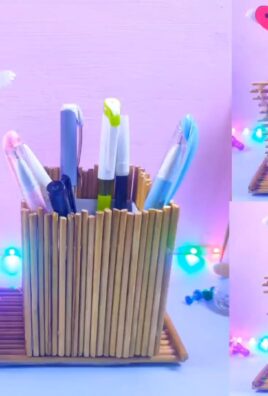Easy home organization routines – sounds like a dream, right? I know, I used to feel completely overwhelmed by the clutter in my own home. It felt like a never-ending battle against piles of paperwork, overflowing closets, and a general sense of chaos. But trust me, it doesn’t have to be that way! This isn’t just another list of generic tips; we’re diving into practical, DIY solutions that you can implement today to transform your space and your mindset.
For centuries, cultures around the world have recognized the importance of an organized home. From the ancient practice of Feng Shui, which emphasizes harmony and balance in living spaces, to the minimalist philosophies embraced in Japanese culture, the idea that our surroundings impact our well-being is deeply ingrained. Think about it – a cluttered space often leads to a cluttered mind, making it harder to focus, relax, and be productive.
That’s where these easy home organization routines come in. We’re not talking about a complete overhaul that will take weeks. Instead, I’m sharing simple, actionable DIY tricks and hacks that you can incorporate into your daily life. These are designed to be sustainable and adaptable to your unique needs and lifestyle. Whether you’re struggling with a messy pantry, a chaotic closet, or just need some help decluttering your living room, you’ll find something here to inspire you. Let’s ditch the overwhelm and create a home that feels calm, functional, and truly reflects who you are!

Easy Home Organization Routines: Conquer the Clutter!
Okay, let’s be honest, keeping a home organized can feel like a never-ending battle. But trust me, it doesn’t have to be! I’ve learned that the key is to establish simple, manageable routines that become second nature. We’re not talking about a complete overhaul every weekend; we’re talking about small, consistent efforts that make a HUGE difference. So, grab a cup of coffee (or tea!), and let’s dive into some easy home organization routines that will transform your space and your sanity!
The Daily Dash: Quick Wins for a Tidy Home
These are the little things you can do every single day to prevent clutter from building up. They take just minutes, but the impact is incredible!
* **Make Your Bed:** Seriously, this is the easiest and most impactful thing you can do. It instantly makes your bedroom look more put-together.
* **One Load of Laundry:** Don’t let laundry pile up! Throw in a load every day (or every other day, depending on your household size). This prevents Mount Washmore from taking over your bedroom.
* **Wipe Down Kitchen Counters:** After every meal, give your kitchen counters a quick wipe. This prevents sticky messes and food buildup.
* **15-Minute Tidy:** Set a timer for 15 minutes and focus on one area that needs attention. It could be putting away mail, clearing off the coffee table, or organizing a drawer. You’ll be amazed at how much you can accomplish in just 15 minutes!
* **Put Things Away Immediately:** This is a big one! Get into the habit of putting things back where they belong as soon as you’re done using them. Keys, shoes, books, remotes – everything has a home!
The Weekly Whirlwind: Tackling Bigger Tasks
These routines are a bit more involved than the daily dash, but they’re still manageable and will keep your home from descending into chaos.
* **Bathroom Blitz:** Give your bathrooms a thorough cleaning once a week. This includes scrubbing toilets, cleaning sinks and showers, and mopping floors.
* **Dusting and Vacuuming/Mopping:** Dust all surfaces and vacuum or mop your floors. This keeps dust bunnies at bay and improves air quality.
* **Meal Planning and Grocery Shopping:** Plan your meals for the week and create a grocery list. This prevents impulse buys and ensures you have everything you need on hand.
* **Declutter One Area:** Choose one area of your home to declutter each week. This could be a closet, a drawer, a shelf, or even just a corner of a room. Get rid of anything you don’t need, use, or love.
* **Check Expiration Dates:** Go through your pantry and refrigerator and toss out anything that’s expired. This prevents food waste and keeps your kitchen organized.
The Monthly Mission: Deep Cleaning and Maintenance
These routines are less frequent but still important for maintaining a clean and organized home.
* **Clean Appliances:** Clean your oven, microwave, dishwasher, and washing machine. This keeps them running efficiently and prevents buildup of grime and odors.
* **Wash Bedding:** Wash your comforter, blankets, and pillows. This keeps your bedding fresh and clean.
* **Clean Windows and Mirrors:** Give your windows and mirrors a good cleaning. This lets in more light and makes your home feel brighter.
* **Organize Paperwork:** Go through your paperwork and file away anything that needs to be kept. Shred anything you don’t need.
* **Check Smoke Detectors and Carbon Monoxide Detectors:** Make sure your smoke detectors and carbon monoxide detectors are working properly. This is a crucial safety measure.
Step-by-Step Instructions for Specific Organization Projects
Now, let’s get into some specific organization projects with detailed, step-by-step instructions.
1. Conquering the Clothes Closet: A Step-by-Step Guide
My closet used to be a black hole of clothes I never wore. Now, it’s a (mostly) organized haven! Here’s how I tackled it:
1. **Empty Everything Out:** Yes, everything! Take all your clothes, shoes, and accessories out of your closet and pile them on your bed. This is the most daunting part, but it’s essential for a fresh start.
2. **Sort and Purge:** This is where the magic happens. Go through each item and ask yourself these questions:
* Have I worn this in the past year?
* Does it fit properly?
* Is it in good condition?
* Do I love it?
If the answer to any of these questions is no, it’s time to let it go. Create three piles: Keep, Donate/Sell, and Trash. Be honest with yourself!
3. **Clean the Closet:** While the closet is empty, give it a good cleaning. Dust the shelves, vacuum the floor, and wipe down the walls.
4. **Organize Your Clothes:** Now it’s time to put your clothes back in the closet. But before you do, think about how you want to organize them. Here are a few ideas:
* **By Type:** Group your clothes by type (e.g., shirts, pants, dresses, skirts).
* **By Color:** Organize your clothes by color within each type.
* **By Season:** Separate your clothes by season and store out-of-season items in bins or bags.
5. **Hang Your Clothes:** Use matching hangers for a more uniform look. Hang your clothes with the hangers facing the same direction.
6. **Fold Your Clothes:** Fold your clothes neatly and stack them on shelves or in drawers.
7. **Organize Shoes and Accessories:** Store your shoes on shelves, in shoe organizers, or in boxes. Organize your accessories in drawers, on shelves, or in hanging organizers.
8. **Add Storage Solutions:** If you need more storage space, consider adding shelves, drawers, or hanging organizers.
9. **Maintain Your Closet:** Make it a habit to declutter your closet regularly. Get rid of anything you no longer need or wear.
2. Taming the Kitchen Chaos: A Step-by-Step Guide
The kitchen is often the heart of the home, but it can also be a source of clutter and stress. Here’s how to create a more organized and functional kitchen:
1. **Clear the Counters:** Start by clearing everything off your kitchen counters. This will give you a clean slate to work with.
2. **Declutter the Cabinets and Drawers:** Go through your cabinets and drawers and get rid of anything you don’t need or use. This includes expired food, broken appliances, and duplicate items.
3. **Organize Your Cabinets:** Group similar items together in your cabinets. For example, store all your baking supplies in one cabinet and all your pots and pans in another.
4. **Organize Your Drawers:** Use drawer dividers to keep your drawers organized. This will prevent items from getting lost or jumbled together.
5. **Organize Your Pantry:** Go through your pantry and get rid of anything that’s expired or that you don’t plan to use. Organize your pantry by category (e.g., canned goods, snacks, baking supplies).
6. **Organize Your Refrigerator:** Go through your refrigerator and get rid of anything that’s expired or that you don’t plan to eat. Organize your refrigerator by category (e.g., fruits, vegetables, dairy).
7. **Create Zones:** Designate specific zones in your kitchen for different tasks. For example, create a cooking zone near the stove, a cleaning zone near the sink, and a food preparation zone on the counter.
8. **Use Vertical Space:** Maximize vertical space by using shelves, racks, and hanging organizers.
9. **Maintain Your Kitchen:** Make it a habit to clean your kitchen counters and sink after every meal. Put away dishes immediately and declutter your kitchen regularly.
3. Mastering the Home Office: A Step-by-Step Guide
A cluttered home office can kill productivity. Here’s how to create a workspace that inspires focus and creativity:
1. **Clear Your Desk:** Start by clearing everything off your desk. This will give you a clean slate to work with.
2. **Declutter Your Drawers and Cabinets:** Go through your drawers and cabinets and get rid of anything you don’t need or use. This includes old papers, broken pens, and duplicate supplies.
3. **Organize Your Desk:** Keep only the essential items on your desk, such as your computer, phone, and a few pens. Use desk organizers to keep your supplies neat and tidy.
4. **Organize Your Paperwork:** Create a filing system for your paperwork. Label your files clearly and store them in a filing cabinet or drawer.
5. **Organize Your Books and Magazines:** Store your books and magazines on shelves or in magazine racks.
6. **Create a Comfortable Workspace:** Make sure your chair is comfortable and that your desk is at the right height. Add plants or other decorative items to make your

Conclusion
So, there you have it! Transforming your living space into a haven of order and tranquility doesn’t require a complete overhaul or a hefty investment. These easy home organization routines, when implemented consistently, can dramatically improve your daily life, reduce stress, and even boost your productivity. The beauty of these routines lies in their adaptability. They’re not rigid rules but rather flexible guidelines that you can tailor to fit your unique lifestyle, space constraints, and personal preferences.
Think of these routines as building blocks. Start with one or two that resonate most with you and gradually incorporate others as you become more comfortable. Don’t be afraid to experiment with different approaches to find what works best for you. Perhaps you discover that a 15-minute tidy-up session before dinner is more effective than a longer session on the weekend. Or maybe you find that using clear storage containers motivates you to keep things organized because you can easily see what’s inside.
The key is consistency. Even small, incremental changes can make a big difference over time. Don’t get discouraged if you miss a day or two. Just pick up where you left off and keep moving forward. Remember, the goal is not perfection but progress.
Consider these variations to personalize your organization journey:
* **Theme-Based Organization:** Dedicate specific days to organizing particular areas. For example, “Monday is Mail Day” for sorting through paperwork, or “Wednesday is Wardrobe Wednesday” for decluttering your closet.
* **Gamify the Process:** Turn organization into a fun challenge by setting timers, rewarding yourself for completing tasks, or competing with family members to see who can declutter the most items.
* **Mindful Decluttering:** As you declutter, take a moment to appreciate the items you’re letting go of and reflect on their purpose in your life. This can help you make more conscious decisions about what you keep and what you donate.
* **Upcycle and Repurpose:** Before discarding items, consider whether they can be repurposed or upcycled into something new. Old jars can become storage containers, and worn-out clothing can be turned into cleaning rags.
* **Digital Detox:** Extend your organization efforts to your digital life by decluttering your email inbox, organizing your files, and unsubscribing from unwanted newsletters.
We truly believe that these easy home organization routines are a game-changer for anyone seeking a more peaceful and productive living environment. We urge you to give them a try and experience the transformative power of an organized home.
And now, we want to hear from you! What are your favorite home organization tips and tricks? Have you tried any of these routines? What challenges did you face, and how did you overcome them? Share your experiences in the comments below. Your insights could inspire others to embark on their own organization journeys and create a more organized and fulfilling life. Let’s build a community of organized individuals who support and encourage each other!
Frequently Asked Questions (FAQ)
What if I don’t have a lot of time for organization?
That’s perfectly understandable! Many people lead busy lives, and finding time for organization can be challenging. The beauty of these easy home organization routines is that they can be adapted to fit even the busiest schedules. Start with small, manageable tasks that you can easily incorporate into your daily routine. Even dedicating just 15 minutes a day to organization can make a significant difference over time. Focus on high-impact areas, such as decluttering your entryway or organizing your kitchen counter. Remember, consistency is key. Even small, regular efforts will yield noticeable results. You can also break down larger tasks into smaller, more manageable chunks. For example, instead of tackling your entire closet at once, focus on organizing one shelf or drawer at a time.
I feel overwhelmed by the amount of clutter in my home. Where do I start?
Feeling overwhelmed is a common experience when facing a cluttered home. The best approach is to break down the task into smaller, more manageable steps. Start by choosing one small area to focus on, such as a drawer, a shelf, or a corner of a room. Declutter that area completely before moving on to the next. This will give you a sense of accomplishment and motivate you to continue. Another helpful strategy is to use the “four-box method.” Label four boxes as “Keep,” “Donate,” “Trash,” and “Relocate.” As you go through your belongings, sort them into the appropriate box. This will help you make decisions about what to keep and what to get rid of. Remember to be ruthless in your decluttering efforts. If you haven’t used an item in a year or more, chances are you don’t need it.
How do I maintain organization once I’ve achieved it?
Maintaining organization is an ongoing process, but it doesn’t have to be overwhelming. The key is to establish habits that prevent clutter from accumulating in the first place. Make it a habit to put things away immediately after using them. This will prevent clutter from piling up on surfaces. Regularly declutter your home, even if it’s just for a few minutes each day. This will help you stay on top of things and prevent clutter from becoming overwhelming. Implement the “one in, one out” rule. For every new item you bring into your home, get rid of one similar item. This will help you maintain a balance and prevent your home from becoming overcrowded. Finally, be mindful of your consumption habits. Before buying something new, ask yourself if you really need it and where you will store it.
What are some good storage solutions for small spaces?
Small spaces require creative storage solutions. Vertical storage is your best friend. Utilize shelves, wall-mounted organizers, and tall cabinets to maximize vertical space. Look for furniture with built-in storage, such as ottomans with hidden compartments or beds with drawers underneath. Use clear storage containers to easily see what’s inside and maximize space. Over-the-door organizers are great for storing shoes, toiletries, or cleaning supplies. Utilize the space under your bed for storing seasonal clothing or extra bedding. Consider using foldable storage boxes that can be easily stored away when not in use.
How can I get my family members to participate in home organization?
Getting family members on board with home organization can be a challenge, but it’s essential for creating a harmonious living environment. Start by explaining the benefits of organization, such as reduced stress, increased productivity, and a more peaceful home. Involve family members in the decision-making process. Ask for their input on how to organize different areas of the home. Assign age-appropriate tasks to each family member. Make organization a family activity by setting aside a specific time each week to declutter and organize together. Lead by example. If your family members see you actively participating in organization, they’re more likely to follow suit. Finally, be patient and understanding. It takes time to develop new habits, so don’t get discouraged if your family members don’t immediately embrace organization.
What if I have trouble letting go of sentimental items?
Letting go of sentimental items can be difficult, but it’s an important part of decluttering. Start by asking yourself why you’re holding onto the item. Is it because it brings back happy memories, or is it because you feel guilty about getting rid of it? If the item brings back happy memories, consider taking a photo of it and creating a memory box or scrapbook. This will allow you to preserve the memories without holding onto the physical item. If you feel guilty about getting rid of the item, remind yourself that you’re not throwing away the memories associated with it. You’re simply making space for new memories to be created. Consider donating the item to someone who can use it. This can help you feel better about letting go of it. Finally, be selective about the sentimental items you keep. Choose the ones that are most meaningful to you and let go of the rest.
How do I deal with paper clutter?
Paper clutter is a common problem in many homes. The first step is to go paperless whenever possible. Sign up for online billing and statements, and scan important documents to create digital copies. Sort through your mail immediately and discard junk mail. Create a filing system for important documents, such as bills, receipts, and insurance policies. Shred any documents that contain sensitive information. Consider using a document scanner to quickly and easily scan large quantities of paper. Finally, set aside a specific time each week to declutter your paper files.





Leave a Comment